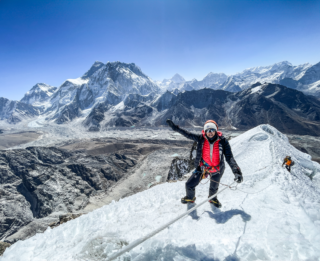
Enduring Nepal
Our LHO Lobuche East Expedition includes trekking to Everest Base Camp and summiting Kala Patthar for acclimatization, preparing you for the challenges of Lobuche East peak climbing. This skills-focused expedition lays a solid foundation for your mountaineering journey, setting you up for success as you aim for the Lobuche East summit and experience the thrill of climbing this epic Himalayan peak.

TRIP TYPE
Climbing and Mountaineering

DURATION
19 Days

DESTINATION
Nepal
1
An all-inclusive Lobuche East climb expedition with the Everest Base Camp trek, a Kala Patthar summit, top-tier tea houses, weather contingency, and a Kathmandu tour to complete the trip.
2
Relive the journey with exclusive photos captured by your LHO Team Leader, included in every Lobuche East climb expedition.
3
Led by an LHO Expedition Coordinator and expert Lobuche East climbing guides, ensuring a smooth, safe Lobuche East climb expedition with full support on and off the mountain.






2026
DATE & STATUS
PRICE
TEAM LEADER
AVAILABILITY
WHAT'S INCLUDED IN THIS TRIP
WHAT'S NOT INCLUDED IN THIS TRIP
DAY 1: WELCOME TO WILD KATHMANDU
Kathmandu is an incredible, vibrant, and wild city that we’ve fallen in love with. That’s why we’re always so excited to receive you on the first day and share the gateway to the Himalayas with you.
On arrival day, you’ll be met by an LHO representative at the airport and driven to our centrally located hotel by private transfer. Navigating Kathmandu airport can be an adventure in and of itself, so you’ll receive a text with detailed instructions on how to efficiently make your way to us.
Your LHO Team Leader will be waiting to receive you at our hotel, check you in, and make sure that you have everything you need for our adventure. If you arrive early, there are loads of incredible places to visit around us. Your LHO Team Leader will send you a detailed list of restaurants, coffee shops, heritage sites, and markets to visit closer to your trip start date so that you can make the most of your time.
Our first official event of the trip is a team dinner at 7:30 pm hosted by your LHO Team Leader and local lead guide. This will be your first opportunity to meet everyone, ask any questions you have, hear all about the amazing week ahead of us, and enjoy a great meal. Although it’s difficult not to be tempted by the nearby nightlife, we recommend an early rest to recover from your travels.
DAY 2: EXPLORING THE GATEWAY TO THE HIMALAYAS
Our first full day together gives us an opportunity to discover the magical city of Kathmandu, check our gear, and get to know each other before we head out to the trail. We’ll visit the nearby sites of Durbar Square and the Monkey Temple as well as get our first taste of Nepali cuisine during our team lunch.
Due to air traffic in Kathmandu airport, the government sometimes takes the decision to assign all flights to the Everest region from an alternative airport three hours away from the city. We’ve determined that waking up exceptionally early on the day of the flight to make the land journey limits the much-needed rest before heading out on our adventure. That’s why, if flights won’t be departing from Kathmandu Airport, we will make our way to a hotel closer to our departure airport today. This gives us a chance to have a full night’s rest. Your Team Leader will inform you about the plans of the day upon your arrival in Kathmandu as this information can change regularly. Regardless, our team dinner will be at the accommodation we sleep at on the night.
DAY 3: TASHI DELEK
Distance: 8.7 KM | Ascent: 364 M | Descent: 521 M | Max Altitude: 2,860 M
Our day starts after breakfast as we make our way to the airport to board one of the most incredible flights you’ll ever take. As with all internal flights, delays are expected. Flights to Lukla are particularly notorious for never departing on time. Not to worry, though, every moment spent waiting is worth it when we get there. The flight itself takes about fifty minutes.
Once in Lukla, we’ll be met by our porter team who will collect our duffle bags and take them to a local tea house where we’ll have lunch and prepare ourselves for the trek to Phakding. Lukla is one of the most vibrant villages in the Khumbu region. It’s an important hub of local and regional commerce as well as the border to the sacred high-altitude regions. Above Lukla, animal slaughter is religiously banned. That’s why we don’t recommend choosing any meat or chicken options above Lukla.
The trail begins at the entrance of the village and is actually mostly descending in the alpine forests and through the many towns that dot this section of the trail. The Tibetan influence and Buddhist character of the area are immediately apparent in the calligraphy, architecture, and religious stupas and shrines.
Our accommodation sits just above Phakding near the Khumbu river that is formed from the melting glaciers of the towering summits of the region, including Everest. Depending on our arrival time, it may be possible to explore the coffee shops and market streets of the village before dinner.
DAY 4: NAMCHE BAZAAR
Distance: 9.1 KM | Ascent: 1,095 M | Descent: 380 M | Max Altitude: 3,440 M
Our second day on the trail will be a full-on ascent to an impressive altitude of 3,445 meters, arriving at one of the most vibrant and remote high-altitude towns on the planet: Namche Bazaar. The trail begins by following the river and passes through the alpine forests. The trail is once again dotted by a series of villages and farming communities that add an incredible element of rural life to the walk.
Our first main objective is reaching the town of Monjo. This is the official entrance to the Sagarmatha National Park. There is a brief checkpoint where we present your permits to the authorities. Once through, we’ll descend a series of staircases flanked by Tibetan calligraphy carved into the rocks. We’ll stop for lunch at the last village in the valley before the direct ascent to Namche Bazaar. The trail to Namche is predominantly ascending and sustained. Your LHO Team Leader will help set the pace so that we can efficiently overcome the challenge without wasting energy unnecessarily.
Slow and steady is the name of the game here as we make our way up a series of stairs, cross the epic Tenzing-Hillary suspension bridge, and join the winding trail through the pine forest that leads to the village entrance. There’s a viewpoint of Everest halfway up to the top. On a clear day, this offers the first opportunity to see the world’s highest summit, albeit from afar. We’ll also use this as an opportunity to take a break and use the serviced bathrooms available there.
The reward at the end of our ascent is our arrival in the incredible Sherpa town of Namche, nestled between the towering summits of the high Himalayas. After checking into our tea house, we’ll have plenty of opportunities to explore the markets, coffee shops, and bars that give this place so much life. This will be our home for the next two nights. Dinner will be at our tea house.
DAY 5: FIRST SIGHT OF EVEREST
Distance: 5.5 KM | Ascent: 503 M | Descent: 503 M | Max Altitude: 3,700 M
We’ll be staying in Namche Bazaar for a second night. That means we don’t have to repack our bags or check out from the Tea House. Our day will slowly start after breakfast. We’ll climb to the top of the town and visit the Sherpa museum where we can learn about the Sherpa culture, mountaineering history of the region, and about new sustainability practices that your visit to the region helps finance.
From there, we’ll trek to the hilltop high above the village to acclimatize by exposing ourselves to higher altitudes. The hilltop offers a jaw-dropping view of Everest, Lhotse, and Ama Dablam, three of the most iconic summits on the planet. We’ll be able to see all the way up the Khumbu valley and get a visual representation of what lies ahead of us.
There’s an opportunity for a short tea break at the Everest View Hotel nearby before we descend back to Namche for lunch at our Tea House and a free afternoon to enjoy the town. Dinner will also be at our Tea House.
DAY 6: THE GREAT MONASTERY OF TYANGBOCHE
Distance: 9.4 KM | Ascent: 901 M | Descent: 454 M | Max Altitude: 3,860 M
If you’ve ever watched a movie or documentary about climbing Everest, then you’ve surely seen scenes from the Tyanboche monastery. This is where climbers come to receive a blessing of protection before ascending the giants of the region. The monastery is exactly where we’re heading.
After breakfast, we’ll depart in the direction of the Sherpa museum, but this time we’ll continue past it and follow the wide trail that heads straight down the valley. The trek is characterized by incredible photo opportunities, stupas, and the unlimited views of towering summits all around and the fewer villages that inhabit these parts. Although the trail does begin above the tree line, we will eventually start descending toward the valley floor, re-entering the thick forest and reaching the riverside once again.
We usually stop for tea along the descending portion of the trail and have a lunch break at the riverside. After lunch and a bit of rest, we’ll begin the long ascent to Tyangboche. Your LHO Team Leader will once again set a manageable pace that ensures you will arrive feeling strong. At 3:30 pm, the monastery opens for visitors, and we’ll have a chance to visit and participate in the rituals of one of Buddhism’s holy sites before dinner and rest at our Tea House.
DAY 7: ABOVE 4000 METERS
Distance: 10.6 KM | Ascent: 773 M | Descent: 279 M | Max Altitude: 4,410 M
The 4000-meter mark is universally considered the start of the high-altitude environment. Today is the day we’ll breach that ceiling and reach 4,400 meters. After breakfast, we’ll descend into a Rhododendron forest. The Rhododendron is the national flower of Nepal, and this forest has an incredible energy that really feels like a border between worlds.
We’ll emerge from the forest onto an iconic suspension bridge, which is where it’s possible to take a photo of trekkers walking above the mountain of Ama Dablam. Once we cross the bridge, we’ll start climbing a series of staircases with the summit of Ama Dablam immediately to our right.
The trail eventually enters the remote town of Pengboche, our lunch stop for the day. After a good meal and some rest, we’ll continue along the trail as it turns behind Ama Dablam and closer to the south face of Lhotse, the world’s fourth-highest summit. The forests are now replaced with limited short grass vegetation as the drier climate becomes more apparent.
Our final destination for the day is Dingboche, our home for the next two nights. Dingboche was once primarily herding grounds for yaks. The town has developed substantially over the past decades due to its position at the crossroads of the main climbing and trekking routes in the region. Dinner will be at our Tea House.
DAY 8: RESTING BENEATH THE ROOF OF THE WORLD
Distance: 3.1 KM | Ascent: 476 M | Descent 476 M | Max altitude: 4,600 M
We’ll be staying in Dingboche for two nights to rest and acclimatize. The Tea Houses in this area are relatively comfortable, giving us the opportunity to relax before pushing into the higher altitude environment.
Depending on the conditions and the spirits of the group, we may choose to take a short walk up to the pass to enjoy the views and acclimatize. This is completely optional, and it’s perfectly fine to choose not to exert yourself at all on this day. There are a few coffee shops worth visiting in the town, and we’ll also have plenty of free time to do that. Both lunch and dinner will be at our Tea House.
DAY 9: THE THUKLA PASS
Distance: 8.2 KM | Ascent: 951 M | Descent: 91 M | Max Altitude: 4,940 M
We’ll get an early start from Dingboche, departing after breakfast in the westerly direction. The close proximity of the mountains and glaciers is immediately apparent when we exit the town. On our left are the towering summits of the Cholatse and Taboche mountain ranges. Ahead of us is Lobuche. Behind us is Ama Dablam, and to our right is the south side of Lhotse and Nuptse. This area is full of wild yaks grazing in the open spaces.
The first portion of the trail is Nepali flat, which means it’s inclined but interrupted regularly by brief flat sections and even small descents. We’ll follow the trail until we reach a river crossing that can sometimes be a little tricky to navigate because of the regularly changing trails. Your LHO Team Leader and guide will brief you on staying together, particularly for this part.
Once we cross the river, we’ll find a small cluster of Tea Houses known as Thukla. This will be the location of our lunch break for the day. After lunch, we’ll begin the ascent to the Thukla pass. Many people will describe this as the most challenging section of the trail. The truth is that with a slow, sustained, and adaptive pace set by your LHO Team Leader, you will hardly notice a difference between this and any other ascent on the trail.
The top of the trail is the infamous Thukla pass, home to the dedications to the many climbers who have died in the surrounding mountains, including Everest. This is a holy place for many, and although we can certainly take pictures, we should also be respectful to those of us who come here to mourn loved ones. After a break, we’ll follow the glacier moraine in the direction of Lobuche. It’s possible to see Pumori for the first time, an impressive 7000-meter mountain that stands freely in the shadow of nearby Everest. The Lobuche Tea Houses will gradually emerge from behind the northeast slopes of Lobuche summit, and we’ll make our way directly to our accommodation. Unlike previous villages, there are no more coffee shops or market streets. We are now in the wild outback of the Nepali Himalayas. Dingboche is the last village on this trail.
DAY 10: EVEREST BASE CAMP
Distance: 13.3 KM | Ascent: 997 M | Descent: 312 M | Max Altitude: 5,364 M
Unlike traditional trekking groups, we choose to depart very early for our hike to Everest Base Camp. The reason for this is that we would like to give ourselves the opportunity to optionally climb Kala Patthar on the same day to catch the sunset on Everest. It is the sunset rather than the sunrise that is exceptionally beautiful from the top because we will be observing the mountain from its west face, which means the colors are most spectacular at sunset. The trail from Lobuche starts flat and is quite similar to the final stretches of our previous day. All that changes when we begin ascending the glacier moraine. The trail shifts dramatically from flat to incredibly hilly as we go up and down the terrain dug up by the glaciers. The trail even goes onto the glacier itself, albeit a section of the glacier almost fully covered by small stones. Once the trail starts to level out, it means we’re arriving at Gorak Shep, the final collection of tea houses before Everest Base Camp. We’ll stop there for tea, and it’s also possible to leave anything we don’t need for the final walk to base camp since we will be staying in the same place tonight. Once we’ve regained some energy, we’ll make our way out along the glacier’s side. The trail is less dramatic than the previous section with more easily navigable areas. The excitement is now super high as the base camp starts to become more and more visible ahead of us. As we approach, the towering summits of Nuptse and Pumori start to give way to the black summit pyramid previously concealed behind them. Mount Everest is finally revealed. From there, it’s a short descent onto the historic Khumbu glacier as we make our way to the famous rock that has welcomed trekkers and climbers to Everest Base Camp for a century. If conditions are favorable, we can take our time at the base camp to take pictures, enjoy the views, and appreciate the incredible achievement of just being there. Our way back is a short retracing of our steps along the side of the glacier and back to Gorak Shep. After lunch, for those of us feeling motivated and capable, it is possible to trek to the summit of Kala Patthar just above Gorak Shep. It takes about three hours and offers the most stunning views of Everest and the region. Your LHO Team Leader will discuss the options with you at lunchtime. Otherwise, it’s possible to simply rest at Gorak Shep for the afternoon and enjoy the achievement.
DAY 11: PREPARING TO ASCEND LOBUCHE
Distance: 4.9 KM | Ascent: 91 M | Descent: 339 M | Max Altitude: 5,164 M
After breakfast, we will start our descent to Lobuche Tea Houses by retracing our steps over the glacier and along the moraine. Arriving in Lobuche is often bittersweet for the team because here is where those of us who are only here to trek to Everest Base Camp will leave. For those of us who are climbing, we’ll check back in to our Tea House and rest. After lunch, we’ll be met by our climbing team and head out onto the nearby ridge for some technical training. The aim of the day is to balance rest with the learning experience. That’s why we’ve split the training over three days so that we don’t have to exert ourselves too dramatically in one go, especially with the challenge of the ascent still ahead of us. Dinner will be at our Tea House.
DAY 12: THE ASCENT OF LOBUCHE BEGINS – 5400 m
Distance: 2.8 KM | Ascent: 359 M | Descent: 63 M | Max Altitude: 5,400 M
After an early breakfast, we’ll begin our ascent to Lower Camp, also known as Advanced Base Camp. The trail to the camp is not technical and requires only mild scrambling skills, similar to what we would have experienced when approaching Everest Base Camp or Kalapathar summit. The trail begins gradually in a southerly direction. We will be able to see the valley we trekked when we hiked to Lobuche from Dingboche a few days earlier. The trail follows the circular cone of the mountain until we reach a series of large rocky structures. Here is where we’ll employ some basic scrambling skills before reaching the plateau above. From there, it’s a short walk to our camp situated next to an incredible glacier lake. The views of the lower Khumbu and Gokyo summits are nothing short of breathtaking. The giants on the Everest side will now be hidden from view by the towering Lobuche East summit above us. The next time we’ll see the roof of the world is from the roof of Lobuche! After checking in and getting the full briefing from your local lead guide and LHO Team Leader, we’ll continue with our training. We’ll once again limit our time to a couple of hours so as not to tire ourselves too extensively. Dinner will be early at the campsite so that we can get a good night’s rest.
DAY 13: LOBUCHE HIGHER CAMP – 5700 m
Distance: 1.2 KM | Ascent: 434 M | Descent: 8 M | Max Altitude: 5,700 M
In some instances, we may choose to climb directly to the summit of Lobuche from lower camp. This may be necessary during seasons when higher camp is either unsafe, not properly equipped, or due to weather considerations. If we choose to climb directly to the summit, we will get an early start with the aim of returning to high camp for one more night. If we follow our regular schedule, then we’ll depart for higher camp after breakfast. The trek begins by circling around to the opposite bank of the glacier lake before ascending a series of rock slabs of varying inclines. Usually, these slopes are not covered in snow and do not require the use of technical gear. We will, however, be wearing our harnesses and helmets because we may require the use of a rope if we encounter any unexpected ice. There are a couple of fixed ropes on the steeper slabs. Higher Camp sits at the very start of the glacier. The slabs lead straight to the camp with some intervening flat parts that are similar to the trails we’ve been used to from earlier in the week. Once we arrive at Higher Camp, we will follow the same procedures that we would have been accustomed to. Check-in comes first. Depending on our arrival time, we may have lunch directly or rest first. The afternoon will consist of training on the use of crampons and ice axes, as well as a review of how to safely use the fixed rope system that we follow all the way to the summit. Dinner will be early at the High Camp so that we can get a full night’s rest.
DAY 14: SUMMIT! SUMMIT! SUMMIT! – 6119 m
Distance: 2.2 KM | Ascent: 587 M | Descent: 1,953 M | Max Altitude: 6,119 M
If we’ve followed Plan B, then this day will be dedicated to descending from High Camp to Pheriche and potentially lower. Following our Plan A, we’ll depart from High Camp just before daybreak. The ascent from High Camp to the summit should take between 3 to 4 hours depending on our pace. We’ll head north from the camp directly beneath the summit where the start of the first fixed rope is located. The exit from the camp towards the summit is the most technically demanding section because of the ice on the rocks. Luckily, we would have had the opportunity to train on exactly that spot on the previous day. We’ll exit the rocky couloir onto a snow slab with clear steps usually dug into the snow and ice by previous climbers. The fixed ropes are easy to follow and guide our way. However, it is important not to rely on them to pull yourself up. You should rely on the training that focuses on using your feet and your balance. It is much more efficient, conserves energy, and is safer. The fixed ropes are there to assist. They are not there to climb for you. The training continues with four consecutive fixed ropes, each of about one hundred meters in length. At the top of the last fixed rope in this series is a plateau of snow and ice just a few meters beneath the summit. The narrow summit ridge and marginally steep section to mount the ridge create a bit of a bottleneck. During big seasons, we may need to wait for other climbers on the plateau before we are able to safely access the summit without obstruction. It takes less than 10 minutes to reach the summit from the plateau. Once on the ridge, the entire Everest range comes into view once again. In fact, from the summit, it is possible to see the 8000 meter summits of Shishapingma, Choy Oyu, Everest, Lhotse, and Makalu. It’s an incredible experience. We will try to spend as much time as we can on the summit to take pictures and appreciate our achievement. Weather and the traffic of other climbers may limit the time we can spend. Either way, we still have a big descent ahead of us, and it’s best to get started as soon as possible. The descent is similar to the ascent in that we’ll follow the fixed ropes all the way back to Higher Camp. We may need to abseil to access the plateau at the start of the descent. Special attention needs to be given to the last section of icy rock. In some instances, abseiling may be desirable there as well. Your guide and LHO Team Leader will always be at an arm’s length to advise you and ensure we are all practicing the safest possible techniques in every situation. Once at the camp, we’ll have a second breakfast, pack up our tents, and start our descent along the rock slabs back to Lower Camp. We are normally able to reach Lower Camp in a relatively speedy fashion since our energy is regained from the higher oxygen absorption at lower altitudes. Depending on what time we arrive, we may either have a snack or lunch before continuing down to the town of Pheriche. Lunch will be at the Tea Houses of Thukla. After some rest, we’ll begin a descending portion of the trail that differs from what we used on the way up. The descent is quite steep as we drop altitude rapidly and find ourselves on a flat, easy walk near the north faces of Cholatse and Tabouche. Ama Dablam will once again come into view straight ahead of us, and Lobuche summit will now be clearly visible directly behind us. At the end of the valley is the town of Pheriche, our home for the evening. Pheriche is a hub for helicopter traffic because it has a high-altitude clinic that provides medical support to nearby climbing expeditions. There are a few coffee shops to visit as life slowly starts to return to the villages of the lower altitude environment. Dinner will be at our Tea House.
DAY 15: THE TREES GROW AGAIN
Distance: 10.5 KM | Ascent: 323 M | Descent: 766 M | Max Altitude: 4,371 M
For those of us who have chosen to take a helicopter back to Lukla and onwards to Kathmandu, this is where we’ll bid our farewells. You will be escorted by a member of the LHO team to Lukla and then be taken to Lukla airport for your flight. Once you land in Kathmandu, a member of the LHO Team will collect you and shuttle you to the hotel. For the rest of us, after breakfast, we’ll reconnect with the trail that follows the Khumbu River in the direction of Ama Dablam. As the valley starts to get steeper, the trail will veer to the right and follow an embankment that reconnects with the ascending trail that goes up to Dingboche. We’ll continue along the descending route until we reach the familiar town of Pangboche, where we’ll stop for lunch and take our time to enjoy the views of the border regions between the lush lower valley and the dazzling white peaks of the upper regions. We’ll resume the descent along the stairs that lead to the suspension bridge on the edge of the Rhododendron forest. The challenging portion of the trail is actually the final ascent in the forest to the pass, where the Tyangboche monastery sits. Depending on the pace of the team, it may be possible to descend beyond the monastery to Tea Houses closer to Namche Bazaar. Your LHO Team Leader and guide will make an assessment closer to the time and brief you on the final destination.
DAY 16: THE HUSTLE AND BUSTLE OF VILLAGE LIFE RETURNS
Distance: 14.5 KM | Ascent: 688 M | Descent: 1,685 M | Max Altitude: 3,860 M
Tyangboche is the last truly remote village along the trail, and nothing represents this more acutely than departing from the monastery and passing through Namche Bazaar. Both are charming and beautiful in their own rights, but they couldn’t be more different. The trail starts with a long descent to the valley floor before crossing a series of suspension bridges and ascending the pine forest to the junction between the Khumbu and Gokyo valleys. In the forest, we’ll stop at a tea house for a break before continuing to the high point of the day. This is the final big ascent of the entire experience. As we approach Namche, we’ll start to see small market stalls along the trail and the familiar sight of donkey caravans that are replaced by yaks in the higher altitudes. From there, it’s a short walk to Namche, where we’ll stop for lunch. Depending on our pace, it may be possible to roam around before we continue our descent through the forest, across the Tenzing-Hillary suspension bridge, and finally to the valley floor where the town of Monjo awaits. Our night will be spent at a Tea House in the town.
DAY 17: THE GATEWAY TO REALITY
Distance: 12.6 KM | Ascent: 722 M | Descent: 715 M | Max Altitude: 2,835 M
The end of the trail is the Sherpa village of Lukla, home to the Tenzing-Hillary airport. Monjo is within a few hours of Lukla. This gives us the option of catching a flight out on this day instead of the next, should we find that weather may obstruct flights on the following day. Assuming that the conditions are favorable, we’ll start slowly after breakfast and take our time to visit and enjoy the many villages that are along this section of the trail. Yes, we did pass through them on the way up, but the mindset was different. It’s so much more enjoyable to have this experience once the objective of the adventure is behind us. Lunch will be in Phakding along the trail, and we’ll have plenty of opportunities to stop for tea and coffee. The final push to Lukla is a mild challenge as we ascend a series of stairs and village trails to the entrance of the town. The afternoon is free to explore the coffee shops, pubs, markets, and stores. We’ll spend our last night on the trail at a local Tea House, where we’ll also share our last trail dinner.
DAY 18: KATHMANDU DOESN'T CHANGE
Hot showers await us on our return to Kathmandu! We’ll be catching our flight out early in the morning; however, this depends entirely on the weather situation. Patience is key when it comes to aviation in Nepal, although we’ll do our best to make it as smooth as possible. Depending on when we move, lunch will either be in Lukla, Kathmandu, or the alternative airport sometimes used to direct Lukla air traffic that is inbound to Kathmandu. Wherever we finally land, we’ll do our best to get you to the hotel as soon as possible so that you can shower, rest, and enjoy Kathmandu before our farewell dinner.
DAY 19: NAMASTE!
The last day together is dedicated to airport transfer and farewells. Breakfast is included on the day. Please make sure to provide us with the correct departure details when filling out your Team Details Form before the first day of the trip so that arrangements can be made. We’ll be arranging your shuttle 3 hours before departure, so please make sure to be near the hotel at the time so as not to be late. For those of us departing late, we’re happy to recommend places to visit or arrange for a city tour if you weren’t able to attend it on the first day. Please communicate any changes to your flight with your LHO Team Leader as soon as possible so that arrangements can be made.
CAN’T TAKE THIS MANY DAYS OFF?
It is possible to shorten this trip to 16 days by taking a helicopter back down from Everest Base Camp. Ask us about the shorter itinerary by reaching out to us at [email protected].

OUR COMMITMENT
We are dedicated to ensuring that everyone involved in our services receives a fair living wage in their respective countries. We invest in our team members, fostering upward mobility within the adventure travel industry, expanding educational opportunities, and offering support wherever we can. By joining an LHO adventure you are directly impacting the incredible people and the remote communities that make these life-changing experiences possible.
LEARN MORE
HEALTH & SAFETY GUIDELINES
We do our best to ensure your wellbeing on LHO adventures. That's why the facilities we use throughout our trips are required to meet our health and safety standards. We also follow the laws and protocols of every country that hosts our adventures. This extends to national regulations requiring Covid-19 testing, vaccination certificates, mask wearing or any other local guidelines that may apply. Contact us for the most up to date protocols related to your destination.
LEARN MOREWhere is Lobuche East?
Why is it called Lobuche East?
When is the best time to climb Lobuche East?
How hard is Lobuche East?
How fit do I need to be to climb Lobuche East?
How high is Lobuche East?
I've never been mountaineering. Can I join the Lobuche East Expedition?
What's the accommodation like on the Lobuche East Expedition?
How can I charge my devices and power banks? Do tea houses charge for using electrical outlets?
How much should I carry as spending cash?
I've heard some expeditions don't go to the real summit of Lobuche East?
PAYMENT PLANS AVAILABLE
FROM £4,370
DOWNLOAD YOUR TRIP GUIDEBOOK
INQUIRE NOW
This adventure is only available as a private trip and is customized to your requirements, experience and skill level. To get started, please fill out the form below. We’ll be in touch soon to put it together for you.
"(Required)" indicates required fields
CONTACT US
We’re passionate about guiding you to epic adventures and beyond. If you have any questions at all, don’t hesitate to reach out. We’d love to hear from you.

